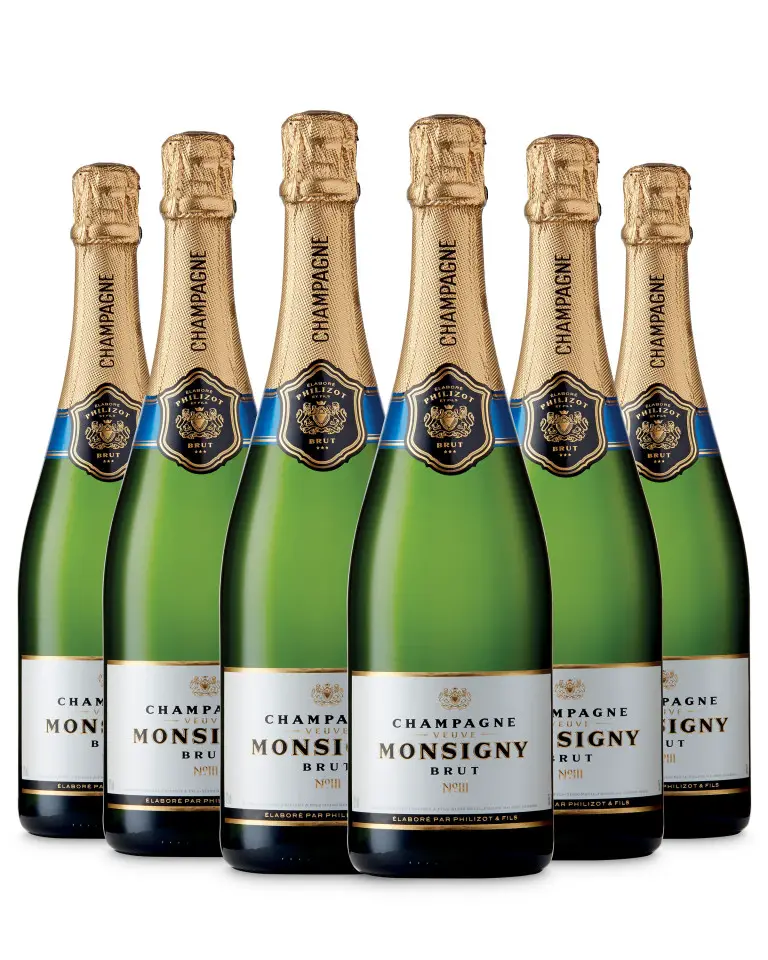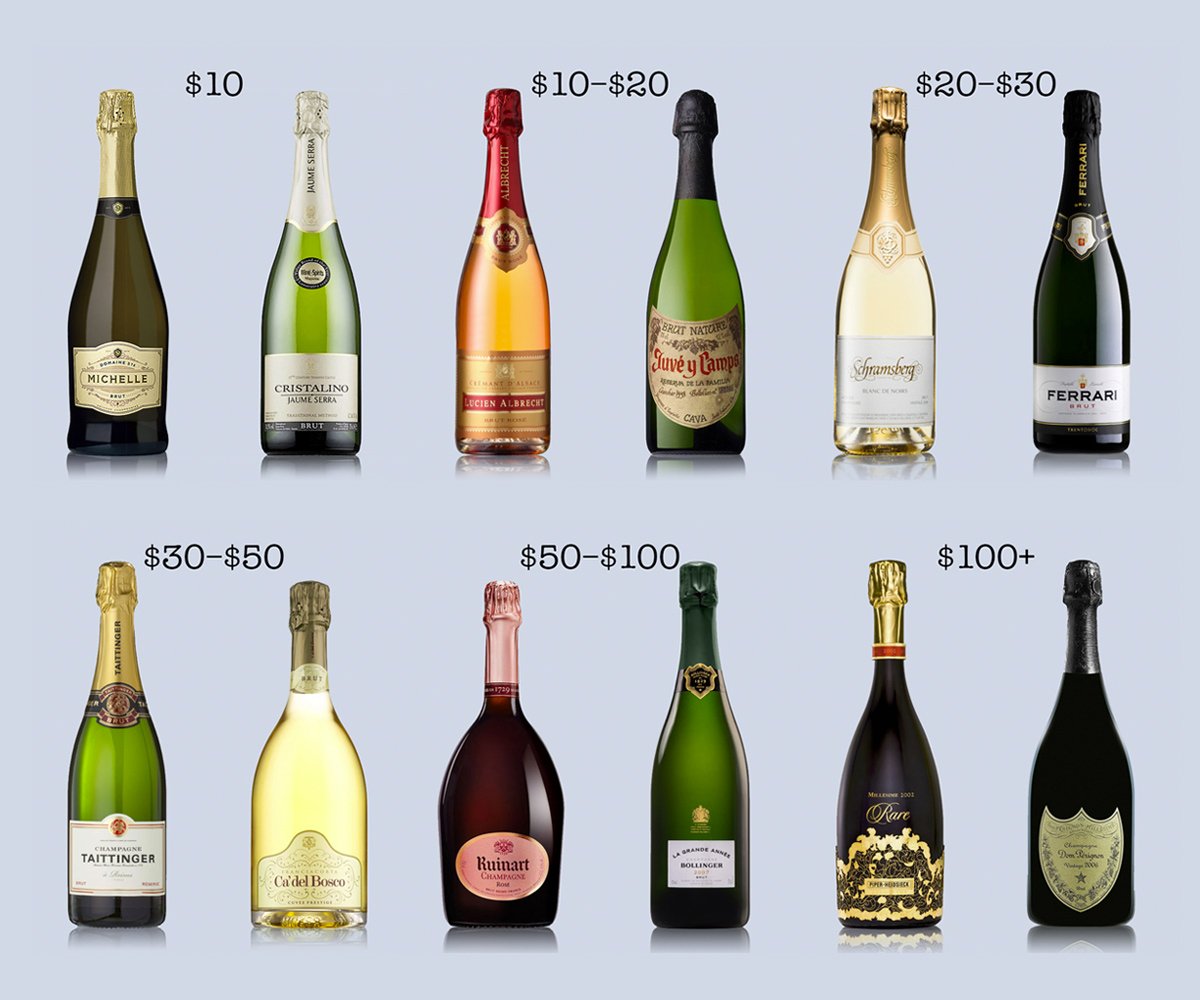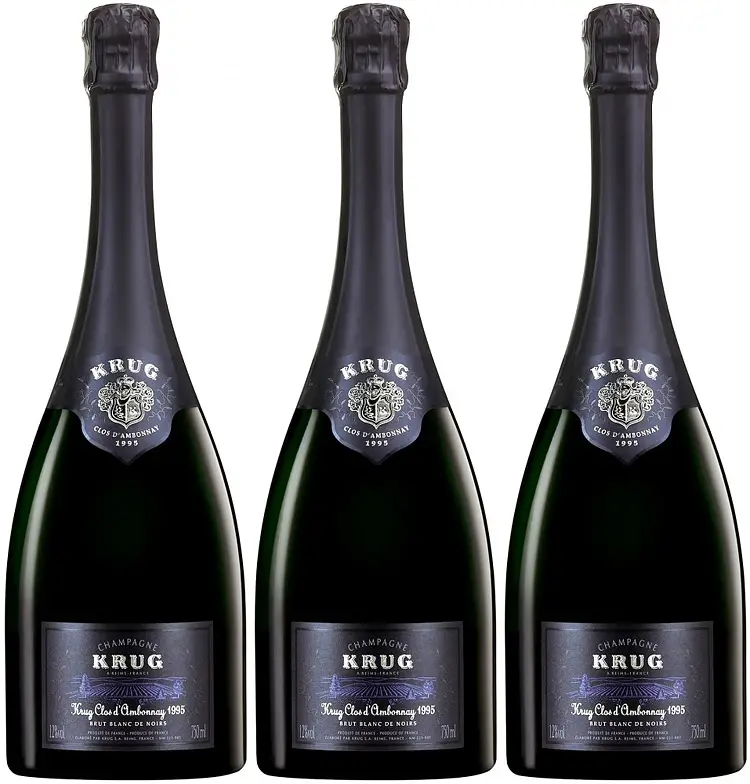Where Does Champagne Come From
You might be wondering why this piece of information is important for the buying guide. You might have also been curious at some point about why we put the word Champagne in quotation marks up there. Relax, well explain.
Everybody knows that Champagne and celebrations go hand-in-hand. Its the world-renowned beverage for toasting and undoubtedly adds to the jollification and delicacy of your festivities by tenfold. However, Champagne, with the capital ‘C’ can only come from the Champagne region in France. And champagne with a lowercase c, well thats your moderately-priced or sometimes even bog-standard sparkling wine if not chosen carefully.
Thats why, in order to choose the just-as-great tasting bubbly as it looks, you may want to look for the word Methode Traditionelle on the wine label. As opposed to Prosecco, Champagne is made using the traditional method where the second fermentation is done in individual bottles precisely the reason behind Champagne being more expensive than other sparkling wines, besides its opulent branding.
What Things Should You Consider Before Buying A Champagne Bottle
Since you now have a firm grip on beginner standpoints, there are a few more things you should consider before buying a Champagne bottle. So, before you speed off to purchase champagne and do the grocery shopping of your next celebration, remember to consider these factors first:
Sweetness
As explained above, theres a whole spectrum of sweetness when it comes to Champagne. You just have to find the spot that properly excites your taste buds. Heres how the spectrum proceeds from least sugar to most sugar added: Bone Dry, Extra Brut, Brut, Extra Sec, Sec, Demi-Sec, Doux
Tasting Notes
If youve got ample time, a good idea would be to search for a specific Champagne online and figure out its tasting notes. These tasting notes are basically notes written by winemakers or people who have tasted a specific wine. This practice may help you guide your taste buds towards or away from Champagnes that you may like or dislike.
Alcohol Content
Your average glass of Champagne has a 10-12 percent alcohol percentage. If, however, you’re looking for an alcohol-free alternative, there are a few brands that produce these as well! For instance, Vinada Sparkling Rose is a sweet sparkling wine and its completely alcohol-free!
Size
The standard size of a Champagne bottle is 750ml. If youll be hosting a couple of guests, you may go for the Magnum size as well which is 1500ml. And if the plan is to go Dutch during a feast, the miniature 200ml sized bottles will come in handy.
Vintage/Non-Vintage
How Do You Estimate How Many Bottles Of Champagne You’ll Need For Mimosas For A Party
The easiest way to determine how many drinks to make for a crowd is to figure out how many people will be drinking and the average number of drinks each guest will have. Then, based on your mimosa recipe, youll be able to estimate the amount of sparkling wine and orange juice youll need, but be sure to have a few extra bottles on hand in case any of your guests end up thirstier than anticipated.
Don’t Miss: Are Wine Coolers Still Made
Right To The Name Champagne
The Champagne winemaking community, under the auspices of the Comité Interprofessionnel du vin de Champagne , has developed a comprehensive set of rules and regulations for all wine produced in the region to protect its economic interests. They include codification of the most suitable growing places the most suitable grape types and a lengthy set of requirements specifying most aspects of viticulture. This includes pruning, vineyard yield, the degree of pressing, and the time that wine must remain on its lees before bottling. It can also limit the release of Champagne to market to maintain prices. Only when a wine meets these requirements may it be labelled Champagne. The rules agreed upon by the CIVC are submitted for the final approval of the Institut national de l’origine et de la qualité .
Devaux D Ros Aged 5 Years

- Producer: Devaux
- Blend: Pinot Noir: 55%, Chardonnay: 45%
- Approx UK Retail Price: £70
This lovely rosé from Devaux, which was a Gold medallist in our 2021 Champagne Masters, delivers the lovely grilled nutty notes that come with extended ageing on the lees at least five years as the name suggests the zestiness that fine Chardonnay brings to the blend, as well as the dry edge that one would expect from a low dosage of 6g/l. Flavour-wise theres plenty of redcurrant fruit, with fresh apple and a touch of pear too, along with a creamy-textured mousse and lingering notes of chalk and roasted coffee bean.
You May Like: Where To Buy Cannonau Wine
How We Tested Champagne
We thought it would be interesting to try the best of the no-name champagnes. We sampled from supermarket own-labels made by giant cooperatives to hand-crafted champagnes made by small growers who use only their own grapes, unusual in Champagne. The wines tried ranged from £10.99 to £35 though the majority were in the £20-30 sweet spot.
Each champagne was tasted blind. Not surprisingly the more expensive bottles, on the whole, tasted better. The conclusion? Around £18 seems to be the minimum you should spend. Anything cheaper, youd be much better going for something sparkling from Australia, New Zealand or Spain.
Q: What Type Of Glasses Do I Need For Champagne
Wine and spirits writer Céline Bossart says that the ideal glass for Champagne is up for debate amongst sommeliers and other wine pros around the world. As Coney pointed out, many will say that a high-quality, all-purpose white wine glass is their top choice. Others swear by a more Champagne-specific style, namely a tulip shape, as coupes and traditional flutes are generally not the best in terms of aroma delivery.
I also once spoke about this with the legendary Godefroy Baijot of Besserat de Bellefon, and he actually prefers to use a tiny stemless Moroccan tea glass, or blida, as its smaller size means more frequent topping-off, so your wine is consistently fresh and ultra-effervescent, she remembers. It also, she adds, makes the Champagne drinking experience feel slightly less stuffy and more convivial, which is never a bad thing. Its an inherently fun, happy wine and should be more approachable, in my opinion, she says. To me, theres nothing better than pouring myself a glass of bubbles on a Tuesday afternoon for absolutely no reason.
You May Like: How To Make Red Wine Taste Better
Alevasseur Noir De Terroir Extra Brut
Best: Blanc de noir champagne
The black label with its elegant font and the wax sealed, rustic string cork tie replacing the usual wire cage immediately signal that this is not your normal champagne. A very small house, going since the 1940s, it makes just around 30,000 bottles a year from four hectares of vineyards scattered around the Marne Valley. This organic, very limited production 100 per cent pinot noir, a blanc de noirs has amazingly complex flavours of brioche, red berry fruit and quince, with a hint of citrus. A great conversation piece to start your dinner party.
How To Choose What Champagne Or Sparkling Wine To Buy
To gather our lists of recommendations, we consulted our panel of experts and looked at expert lists of best Champagnes, sparkling wines, cavas, proseccos, crémants, and more from Wine Enthusiast Magazine, Food and Wine, , Wine Folly, The New York Times, and The Chicago Tribune. If you feel overwhelmed in the store or while searching online, here are some things to keep in mind.
You May Like: How To Make Your Own Wine At Home
Laherte Frres Ros De Saigne Les Beaudiers Extra Brut Nv
Part of the Air’s philosophy is going beyond the mainstream labels we as consumers know and love though these certainly have a time and a place and exploring wines from smaller houses that grow their own grapes. “The people that are on our list are moms, dads, sons, and daughters,” says Amanda Echevarria, who has worked at Air’s since 2017. For Echevarria, supporting growers throughout her career has been important from both an economic and social perspective, and some of her most meaningful experiences along the way have revolved around Champagnes from small purveyors. Picking favorites can be tough, she tells me, but she’s always had a soft spot for pinot meunier grapes .
“There’s more to Meunier than meets the eye this grape is so versatile, and that’s the very reason I adore it. You can expect flavors crisp, poached pears and graham cracker to earthy, cheesy mushrooms or jammy prunes, currants, and cherries. This grape is a giver.” Both Echevarria and Ogando are die-hard fans of this bone-dry rosé by Laherte Frères, an embodiment of all there is to love about pinot meunier that’s relatively easy to find, says Echevarria. Ogando describes the flavor profile: “This wine taunts my palate with white chocolate-covered cherry and lightly dried herbs. It’s a vivacious and slightly creamy delight an absolute must-have.”
To buy: $75, winex.com
What Makes A Bad Champagne
Disappointing champagnes and there are many, sadly will have been made from inferior grapes, matured for the minimum period and will result in a green acidity that has been merely masked with sugar. Wines like these are the reason many people think champagne is over-hyped. Those lovely toasty, bready notes take time to arrive and time is money. No wonder most of us just reach for one of the big names .
Read Also: Where Can I Buy Wine Slush Mix
How To Serve Champagne
Champagne is best served cool, not ice-cold, ideally between 8 and 10°C. Once youre ready to enjoy your Champagne, fill an ice bucket for 15-20 minutes with ice and one-third water. The best glasses to serve Champagne are flute or tulip-shaped glasses , which help accentuate the aromas and direct bubbles upwards.
Vincent Couche Champagne Extra Brut Sensation 1999

A few blocks down from Air’s Champagne Parlor is sister restaurant Niche Niche, where sommelier Hugo Wai pours from a rotating list of idiosyncratic wines often organic, biodynamic, or sustainable in some way selected by guest wine pros to accompany tasting menus from various chefs-in-residence. His favorite Champagne of all time? Vincent Couche’s Sensation 1999 vintage.
“I tasted this Champagne for the first time back in 2019 when it had just been released after chilling and hanging out on the lees for 20 years,” says Wai, who has long since been an avid fan of Couche’s work. “I am a true believer that tasting notes are subjective, and that you get what you get, but here’s what I took from this vintage: honeyed yellow apple, the faintest hint of mushroom, lemon meringue, lemon yogurt, freshly baked brioche, and wow, the acid it’s as zippy as Kramer’s hair from Seinfeld ,” he shares.
“As you can imagine, these wines are very limited truly unicorn Champagnes so if you happen to see this on a wine list or at a wine store, please do yourself a favor and get it.”
To buy: $143, sipfinewine.com
Also Check: What Takes Red Wine Out Of Carpet
Joseph Perrier Cuve Royale Brut Ros
- Producer: Champagne Joseph Perrier
- Grape varieties: 40% Pinot Noir, 40% Chardonnay, 20% Meunier
- Approx. retail price: £45
Aged on the lees for 3-to-5 years in cellars dug out of ancient Gallo-Roman chalk pits, this rosé Champagne is serious, and seriously delicious. Displaying a medium vieux rose hue and narrow cordon, the wine exudes summer pudding fruits and fresh bread notes. On the palate, the wine shows finesse in its light body, zippy acidity and crackling mousse texture. Nicely balanced with good length. Quite vinous, this wine is a lovely aperitif but will also work well with wild salmon or even light desserts.
The Best Sparkling Ros Under $50
Closer to $50, you can start to find rosé Champagne, but the majority of sparkling wines under that price are from other regions. There are many rosé crémants from France that are around $25, but you can also get bottles from Italy, the US, and elsewhere for a similar price.
What our experts particularly like
“I would definitely hold up against any of the other sorts of higher-end wines that you would find out of Champagne,” said Ball of Dirty Radish.
Don’t Miss: What Is The Best Wine To Serve With Ham
Champagne B Stuyvesant Ros
“I love supporting women-owned Champagne brands that are carving out their overdue space in the industry,” says Erica Davis, CEO and co-founder of The Sip, a sparkling wine subscription concept based in Oakland, California. Davis counts this rosé Champagne by B. Stuyvesant, a new Champagne label created by Brooklyn native M. Robinson, among her current favorites. “Complex and beautiful, and made by a Black women-owned brand, this Champagne is a blend of my two favorite grapes, pinot meunier and pinot noir. It’s literally a party in your mouth and pairs great with any seafood dish,” Davis says.
To buy: $68, stuyvesantchampagne.com
What Is The Best Champagne
The best Champagne is the one that appeals to your palate and pairs with what youre eating. Champagne comes in many different styles and sweetness levels, so youll want to try a few to find the ones you like best. The choices include Blanc de Blancs made from 100% Chardonnay brut rosé, often a blend of purple and white grapes and rich-tasting Blanc de Noirs made from purple grapes. You can also find Champagnes with different levels of sweetness ranging from bone dry brut nature, which is great for people following a keto diet to popular brut Champagne, to demi-sec dessert styles, such as Moet Champagne Nectar Imperial.
Don’t Miss: How To Remove Wine Stain From White Shirt
Champagne Valentin Leflaive Cv 17 50
This 100 percent Chardonnay Champagne has a nice, savory quality on the nose. Its terroir-driven palate will please grower Champagne drinkers, along with a funkiness to wake up the senses. This is a bubbly to sip throughout the day. Pull it out for aperitif hour this is a wine to please a crowd.
How To Choose The Best Champagne For You
How much should I spend?
Most bottles of non-vintage Champagne are priced within the £25-45 bracket, but there are exceptions on both sides of this price range. Supermarket own-brand Champagne is often extremely competitively priced, with some bottles even dropping to around £10 during party season. Supermarkets are doing an increasingly good job of sourcing their Champagne too, so its worth experimenting even with the bargain basement bottles to discover what you can find.
Big-name Champagne houses can produce bottles with prices running well into triple figures. This is particularly true for older vintages, which have longer winemaking processes and huge marketing budgets. The key thing is to work out what style you like, then match your budget accordingly.
Vintage or non-vintage ?
As already mentioned, vintage Champagnes are more expensive, but they also tend to taste different to non-vintage varieties. Vintage Champagnes usually spend longer on the lees and have those prized deep, bready, brioche notes as a result. Non-vintage Champagnes are more likely to have fresher, citrus and floral notes.
Also Check: What Kind Of Wine With Pasta
Grapes And Types Of Champagne
Real Champagne must be produced with approved grape varietals: Pinot Noir , Pinot Meunier , and Chardonnay being by far the most commonly used grapes in champagnes. Other approved grapes include Pinot Blanc, Pinot Gris, Petit Meslier, and Arbane.
The primary types of Champagne are Blanc de Blancs, Blanc de Noirs, and Rosé, indicating the varieties and the colors of the grapes used.
Blanc de Blancs means the champagneis made using 100% Chardonnay its light and dry taste makes this type of Champagne a popular choice for apértifs.
Blanc de Noirs are white champagnes made from the black grape varieties of Pinot Noir and Pinot Meunier. Blanc de Noirs Champagnes tend to be richer and full-bodied.
Pink or Rosé champagnes are produced by adding a small amount of Pinot Noir or by pressing the grape skins .
Most champagnes are non-vintage , meaning they are made from a blend of wines made from grapes from different years, as opposed to one years harvest for vintage or millesimé Champagne .
Vintage Champagnes typically reflect the qualities of a single year. Each Champagne house decides whether it will produce a Vintage Champagne in any given year. Non-Vintage Champagnes, on the other hand, reflect a signature house style that tastes consistent year on year.
Best For Mimosas: Billecart

Wine.com
Region: Champagne, France | ABV: 12% | Tasting Notes: Tangy, Red berries, Fresh and vivacious
This is the benchmark Champagne rosé that top sommeliers keep stocked for every occasion. You can’t go wrong with Billecart, which has been producing bubbly for more than 200 years. With mouthwatering, tangy acidity, a wave of strawberry, cherry and raspberry fruit, along with immense freshness and verve, it is best enjoyed solohowever, the rosé will pair perfectly with a nice, Sunday morning Mimosa.
Also Check: Is Red Wine On The Keto Diet
Wine Producing Districts Of Champagne
Champagne is a single appellation d’origine contrôlée but the territory is divided into next sub-regions, which are known as wine-producing districts and each of them has distinct characteristics. The main wine-producing districts of the Champagne wine region: Reims, Marne Valley, Côte des Blancs, Côtes des Bar, Côtes de Sezzane.
As a general rule, grapes used must be the white Chardonnay, or the dark-skinned “red wine grapes” Pinot noir or Pinot Meunier, which, due to the gentle pressing of the grapes and absence of skin contact during fermentation, usually also yield a white base wine. Most Champagnes, including Rosé wines, are made from a blend of all three grapes, although blanc de blancs Champagnes are made from 100% Chardonnay and blanc de noirs Champagnes are made solely from Pinot noir, Pinot Meunier or a mix of the two.